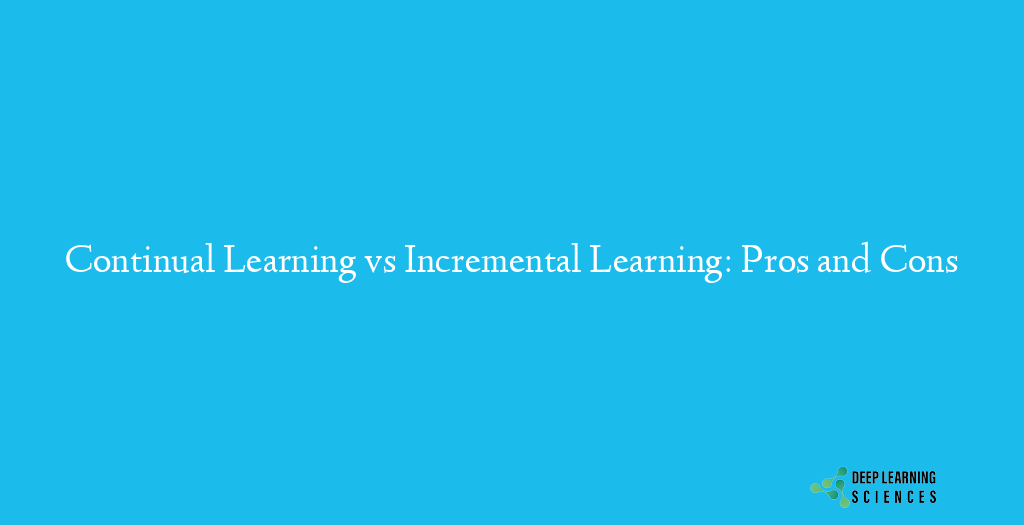In today’s rapidly evolving world, the importance of lifelong learning cannot be overstated. With new technologies, industries, and trends emerging every day, it has become imperative to continuously acquire and improve one’s knowledge and skills. Two approaches that have gained significant attention in the field of machine learning are Continual Learning and Incremental Learning. While both aim to facilitate lifelong learning, they differ in their methods and objectives. In this blog post, we will delve into the concepts of Continual Learning and Incremental Learning, their advantages and disadvantages, and compare and contrast the two approaches to help you understand which one is suitable for your learning goals.

Continual Learning
Continual Learning is an approach to machine learning that involves learning continuously over time without forgetting previously acquired knowledge. It is a key component of lifelong learning, where the objective is to improve performance on new tasks while retaining the ability to perform previously learned tasks. Continual Learning differs from traditional machine learning approaches, where models are trained on a fixed dataset and then tested on a separate set of data. In this section, we will discuss Continual Learning in more detail, including its benefits, challenges, and strategies to prevent catastrophic forgetting.
A. Definition of Continual Learning
- Explanation of Continual Learning as an approach to lifelong learning
- How Continual Learning differs from traditional machine learning
B. Catastrophic Forgetting
- Definition of Catastrophic Forgetting
- Explanation of how it occurs in Continual Learning
- Examples of Catastrophic Forgetting in real-world scenarios
C. Strategies to Prevent Catastrophic Forgetting
- Regularization techniques
- Replay methods
- Dynamic architectures
- Knowledge distillation
- Elastic Weight Consolidation (EWC)
D. Advantages and Disadvantages of Continual Learning
- Advantages, such as adaptability and scalability
- Disadvantages, such as computational complexity and potential performance degradation
E. Applications of Continual Learning
- Real-world applications of Continual Learning, such as personalized healthcare and autonomous driving
- Potential future applications of Continual Learning
F. Limitations of Continual Learning
- Limitations of Continual Learning, such as limited resources and lack of large-scale benchmarks
Incremental Learning
Incremental Learning is another approach to lifelong learning that involves learning new information incrementally over time. Unlike Continual Learning, which focuses on preserving previously learned knowledge, Incremental Learning is more concerned with updating existing models to include new data. In this section, we will discuss Incremental Learning in more detail, including its benefits, challenges, and how it differs from Continual Learning.
Also Read: Softmax Vs Sigmoid – Detailed Points
A. Definition of Incremental Learning
- Explanation of Incremental Learning as an approach to lifelong learning
- How Incremental Learning differs from Continual Learning
B. Advantages and Disadvantages of Incremental Learning
- Advantages, such as efficiency and scalability
- Disadvantages, such as potential performance degradation and the need for sufficient data
C. Incremental Learning Techniques
- Transfer Learning
- Online Learning
- Active Learning
- Meta-Learning
D. Applications of Incremental Learning
- Real-world applications of Incremental Learning, such as recommendation systems and fraud detection
- Potential future applications of Incremental Learning
E. Limitations of Incremental Learning
- Limitations of Incremental Learning, such as the need for sufficient data and potential overfitting
Continual Learning vs Incremental Learning
Both Continual Learning and Incremental Learning aim to facilitate lifelong learning, but they differ in their methods and objectives. Here is the difference between these two presented on the table.
| Continual Learning | Incremental Learning | |
| Objective | Preserve learned knowledge while adapting to new information | Incorporate new information into existing knowledge |
| Key Challenge | Catastrophic forgetting | Overfitting |
| Data Availability | Can work with limited data | Relies on sufficient data availability |
| Computational Cost | Requires significant computational resources | Can be more computationally efficient |
| Performance Trade-Offs | Potential for performance degradation over time | Potential for performance improvements with more data |
| Techniques | Regularization, Replay, Dynamic architectures, Knowledge distillation, EWC | Transfer Learning, Online Learning, Active Learning, Meta-Learning |
| Applications | Personalized healthcare, Autonomous driving | Recommendation systems, Fraud detection |
| Limitations | Potential for computational complexity and performance degradation | Potential for overfitting and the need for sufficient data |
| Ongoing Research | Strategies to improve scalability and performance | Techniques for reducing overfitting and improving efficiency |
Conclusion
In conclusion, both Continual Learning and Incremental Learning are essential for facilitating lifelong learning, and ongoing research in both areas is necessary to improve their performance and scalability. By choosing the right approach for the specific task or scenario at hand, we can continue to adapt to new information while preserving existing knowledge.
FAQs
What is Continual Learning?
Continual Learning is an approach to lifelong learning that aims to preserve previously learned knowledge while adapting to new information.
What is Incremental Learning?
Incremental Learning is an approach to lifelong learning that aims to incorporate new information into existing models.
What are the key challenges in Continual Learning?
The key challenge in Continual Learning is preventing catastrophic forgetting, which occurs when previously learned knowledge is overwritten or lost when learning new information.
What are the key challenges in Incremental Learning?
The key challenge in Incremental Learning is overfitting, which occurs when a model becomes too specialized to the specific data it has seen and is unable to generalize to new data.